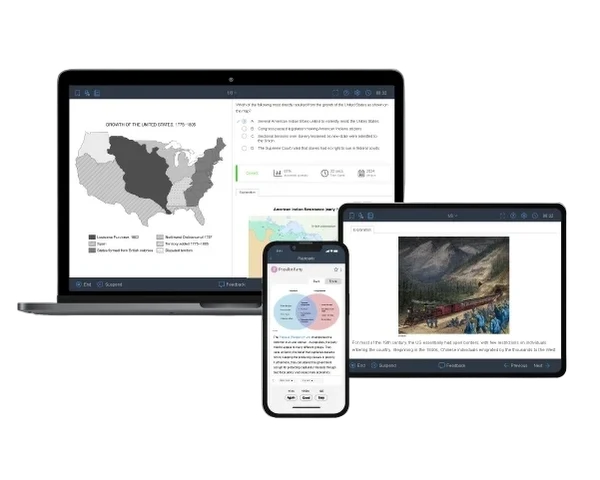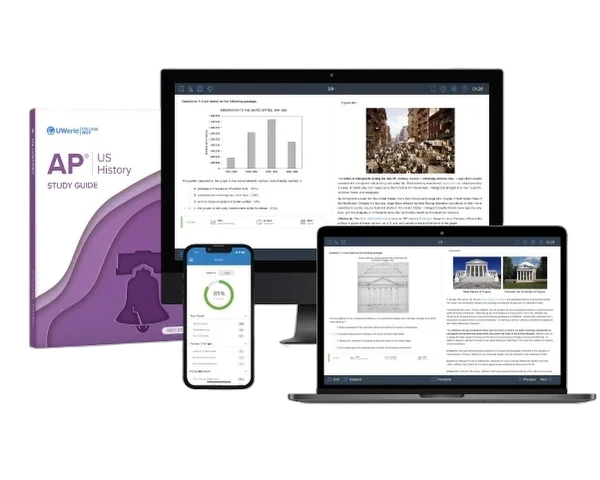The AP U.S. History exam, also known as APUSH, is a college-level exam taken in May after completing the AP U.S. History course. There are many benefits to passing the APUSH exam, but you must prepare in advance and use the right study tools to do well. A high APUSH score can earn you college credit and placement.
What Is AP U.S. History Equivalent to, and Who Can Take It?
Before enrolling, take a moment to review APUSH at a glance— the course is equivalent to a two-semester introductory U.S. history course in college. Although the course has no prerequisites, most students wait until 11th or 12th grade to take it. The College Board® indicates that any student enrolled in the APUSH course should be able to read a college-level textbook and compose complete, grammatically correct sentences.
The AP U.S. History course teaches high school students about individuals, events, and changes throughout U.S. history across nine distinct historical periods from 1491 to the present day. Students will analyze primary and secondary sources, make historical connections, and use comparison, causation, continuity, and change reasoning to develop historical arguments.
You should know that APUSH is a challenging course, so any prior AP experience is helpful. Due to the difficulty of this course, students should take practice exams through a premium test-prep resource to prepare for the end-of-course AP exam.
Why Should I Take the AP U.S. History Course and Exam?
In 2024, AP U.S. History was the second most popular AP course, with 488,688 students taking the exam. However, each student is unique, and your decision to enroll in AP U.S. History should be based on factors other than its popularity. Consider the following three factors when deciding whether to go for AP United States History.
- APUSH will help you develop the analytical reasoning and critical thinking skills necessary for success in advanced high school and college courses.
- Taking an AP course such as APUSH will make your transcript stand out to college admissions committees. Having AP classes on your transcript demonstrates to colleges that you are committed to learning and well-prepared for college-level coursework.
- If you earn a score of 3 or higher on the AP US History exam, you can earn around 3- 6 hours of college credit. This will save you time and money during your first year of college.
APUSH is considered one of the most valuable AP courses you can choose in high school, despite its challenging nature. The course demands extensive reading, writing, and memorization to succeed. Although achieving an A demands significant dedication, the rewards of improving your overall GPA and strengthening your college applications are worthwhile. Additionally, taking APUSH develops your critical thinking skills and makes you more adept at engaging in political and historical debates. Although it can be time-consuming, the benefits of taking this course are well worth it. Let's explore a few advantages of enrolling in AP History:
- College Readiness: Enrolling in challenging AP courses such as APUSH demonstrates to college admissions committees that you are prepared for college-level coursework. AP students are more prepared for college coursework than others.
- College Credits: Many colleges will grant credit if you score 3 or higher on the AP U.S. History exam. This means you can potentially complete your degrees more quickly, reduce your overall course load each semester, and access advanced coursework earlier in your college journey.
- Save on College Tuition: While the initial cost of taking AP exams may seem significant, it's usually much lower than the cost of college tuition for the equivalent courses. By paying for AP exams and performing well, you can potentially save thousands of dollars in college tuition over the course of your education. The minimum credit requirement varies by school. So, remember to research your target colleges' AP credit and placement policies beforehand.
- In-depth subject knowledge: AP U.S. History prepares you for college-level history courses and more. Your AP classes' rigor and challenges will build your confidence and skills for harder classes.
- Reading and Writing Mastery: APUSH involves an extensive amount of content. It necessitates substantial reading and writing, which can enhance your reading and writing abilities compared to a non-AP course.
Do I Need an AP U.S. History Course to Take the APUSH Exam?
Students with a solid background in the subject or those who have self-studied the course can take the exam without enrolling in the APUSH class. Students enrolled in the APUSH course can take the exam in the spring but are not required to do so. Nonetheless, due to the benefits of taking the exam, most students who enroll in the course also take the exam at the end of the academic year.
What Is on the AP U.S. History Exam?
The AP US History exam tests your critical thinking and analytical skills in six categories:
- Developments and Processes: Identify and describe historical developments and processes.
- Sourcing and Situations: Analyze the origin and context of primary and secondary sources.
- Claims and Evidence in Sources: Analyze claims and evidence in primary and secondary sources.
- Contextualization: Analyze the historical contexts of events, developments, or processes.
- Making Connections: Analyze patterns and links using historical reasoning (comparison, causality, continuity, and change).
- Argumentation: Construct an argument.
As an APUSH student, you must be able to read and analyze historical sources, considering the author, historical context, the author's point of view, and the intended audience. You’ll also need to apply the following reasoning processes: Comparison, Causation, Continuity, and Change.
In addition to these skills, the exam will test your knowledge of the eight “Themes” that form the core themes of the course. Let’s learn a bit about those below:
- American and National Identity (NAT): This theme focuses on how American and national identities and values have developed among North America's diverse and changing population. You’ll also learn how these values have contributed to citizenship, constitutionalism, foreign policy, assimilation, and American exceptionalism.
- Work, Exchange, and Technology (WXT): You’ll learn about technology, economic markets, and government in economic exchange systems.
- Geography and the Environment (GEO): The third big idea examines geography and natural and human-made environments in the context of U.S. social and political development.
- Migration and Settlement (MIG): You’ll learn how and why immigrants adapt to new social and physical environments.
- Politics and Power (PCE): Under this theme, you’ll learn how social and political groups have influenced U.S. society and government and how political beliefs and institutions have changed over time.
- America in the World (WOR): This big idea focuses on colonial-era interactions between nations and U.S. global influence.
- American and Regional Culture (ARC): You’ll learn how national, regional, and group cultures evolved and influenced government policy and the economy.
- Social Structures (SOC): The final big idea examines how social organizational systems evolve and impact society.
These themes are taught across nine different units throughout the school year, and each of these units is tested on the exam. The following table details the units tested and their relative importance in the examination.
| Units Tested | Chronological Period | Weight on the Exam |
|---|---|---|
| Unit 1: Period 1 | 1491 to 1607 | 4%–6% |
| Unit 2: Period 2 | 1607 to 1754 | 6%–8% |
| Unit 3: Period 3 | 1754 to 1800 | 10%–17% |
| Unit 4: Period 4 | 1800 to 1848 | 10%–17% |
| Unit 5: Period 5 | 1844 to 1877 | 10%–17% |
| Unit 6: Period 6 | 1865 to 1898 | 10%–17% |
| Unit 7: Period 7 | 1890 to 1945 | 10%–17% |
| Unit 8: Period 8 | 1945 to 1980 | 10%–17% |
| Unit 9: Period 9 | 1980 to the present | 4%–6% |
AP U.S. History Exam Format for 2025
The duration of the AP US History exam is 3 hours and 15 minutes, and it is administered both in paper-and-pencil and digital formats. Each section of the AP United States History exam consists of two parts. The table below shows the duration of each section and part, as well as the number of questions and their types:
| Sections | Parts | Question Types | Time Allocated | Weight |
|---|---|---|---|---|
| Section I | Part A | 55 MCQs | 55 minutes | 40% |
| Part B | 3 SAQs | 40 minutes | 20% | |
| Section II | Part A | 1 DBQ | 60 minutes | 25% |
| Part B | 1 LEQ | 40 minutes | 15% |
Let us explore these question types one by one.
Section I, Part A: Multiple-Choice (MCQ)
Part A of Section I has 55 MCQs, and you have 55 minutes to complete them. These three- to four-question sets require knowledge of APUSH key concepts such as historical text, interpretation, and evidence analysis. There are graphs, maps, and images, as well as primary and secondary sources, included.

Section I, Part B: Short Answers (SAQ)
Section I, Part B, has 3 SAQs and takes 40 minutes to complete.
- Question 1 is mandatory. It includes 1-2 secondary sources and focuses on historical events from 1754 to 1980.
- Question 2 is also mandatory. It includes one primary source and focuses on historical events from 1754 to 1980.
- Question 3 will give you two choices. One choice will be based on historical events between 1491 and 1877, while the other will cover events from 1865 to 2001. You are required to choose one and answer it.
Section II, Part A: Document-Based Questions (DBQ)
For the DBQ, you will be given seven documents that offer distinct perspectives on a historical event or process. You must evaluate the perspectives and construct an argument based on a proper analysis of historical evidence. This question focuses on the time span from 1754 to 1980.
Section II, Part B: Long Essay
You will be asked to write a convincing argument based on historical evidence from one of three different time periods in U.S. history for the long essay: 1491–1800, 1800–1898, or 1890–2001.
Both sections of the exam have strict time constraints, so prepare thoroughly with a reliable online resource before sitting for your APUSH exam.
Want to learn more in-depth information on the exam format? Our guide to the APUSH exam format is here to help!
Is AP U.S. History Hard?
AP U.S. History is a rigorous course that covers the entirety of U.S. history in one academic year. Students will be studying historical events from 1491 CE to the present day, so there is substantial data to process and remember. Despite being the second most popular AP course, it has a lower pass rate and fewer 5-point scores than other courses. Here are the past three years APUSH exam results.
- Graph View
- Table View
| APUSH Exam Score | %age of Test Takers in 2024 | %age of Test Takers in 2023 | %age of Test Takers in 2022 |
|---|---|---|---|
| 5 | 12.8% | 10.6% | 10.8% |
| 4 | 33.3% | 14.8% | 15.6% |
| 3 | 26.0% | 22.1% | 21.9% |
| 2 | 19.4% | 22.7% | 23.0% |
| 1 | 8.4% | 29.8% | 28.8% |
| 3+ | 72.2% | 47.5% | 48.3% |
| Mean Score | 3.23 | 2.54 | 2.57 |
| Total test takers | 488,688 | 467,975 | 456,520 |
Historically, scoring a 3 or higher on the AP U.S. History exam has been challenging. In 2022, only 48.3% of students reached this benchmark, and in 2023, that number dropped to 47.5%. However, 2024 marked a dramatic improvement, with 72.2% of students achieving a 3 or higher. This surge may be linked to the course’s demanding nature, which emphasizes analytical thinking, recalling complex information, and strong writing skills.
AP U.S. History Review Tips
You are likely curious about the best ways to prepare for the exam so you can earn a 3, 4, or 5. The most important way to start preparing is to follow a thorough learning schedule with systematic practice. It is essential to take regular practice tests with exam-like questions and familiarize yourself with the rubric for free-response questions. Below are a few pointers for a head start:
- Have a schedule and commit to it. The AP US history course has much to read and memorize, and your exam prep will be time-consuming. The best way to do it is to prepare a dedicated study plan and stick to it. Need help? Use our APUSH study plan to create a learning study schedule tailored to your needs!
- Practice is key. Research indicates that practicing with questions similar to those found in exams can accelerate learning and improve long-term retention. Taking regular practice tests with exam-like questions will help you learn the multiple-choice question rubric. You can also practice FRQs from past APUSH exams on the College Board website.
- Pick the right tools. Taking quality practice tests with a performance tracker will help you measure your test prep progress. With every practice test, you’ll be able to identify your opportunities for improvement and work on them. That way, you will have better odds of acing the exam.
- Know the exam format. Learning the exam format thoroughly will improve your time management skills, so you will have extra time to review your answers at the end of the exam.
Want to start preparing for the AP United States History exam but are unsure where to start? Try UWorld’s APUSH course and online learning tools. You’ll get:
- Hundreds of questions in the APUSH QBank to simulate the format and difficulty level of the APUSH exam
- A dedicated study guide with comprehensive coverage of content, thorough answer explanations with illustrative examples
- A performance tracking tool to measure your progress and identify problematic areas
Prepare with UWorld for your AP exams and see why students love it!

Frequently Asked Questions (FAQs)
How long is the APUSH exam?
When is the AP U.S. History exam in 2025?
What do I bring to the AP U.S. History exam?
You can bring the following items to the APUSH exam testing room:
- A watch.
- A school-issued or government-issued photo ID (required if testing at a school other than your own).
- A fully charged device and its power cord.
- College Board account login details.
- Pens or pencils for writing on scratch paper provided by the school.
- Optional: An external mouse.
- External keyboard requirements: Must be used if testing on a tablet or iPad. Not allowed for students using a laptop.
What happens if you fail the AP U.S. History exam?
When do students usually take AP U.S. History?
How much does the AP U.S. History exam cost?
References
- Past AP United States History Score Distributions. (n.d.). Retrieved December 18, 2024, from https://apstudents.collegeboard.org/about-ap-scores/score-distributions/ap-united-states-history
- AP U.S. History Course and Exam Description. (Fall 2023). Retrieved December 18, 2024, from https://apcentral.collegeboard.org/media/pdf/ap-us-history-course-and-exam-description.pdf
- What Students Should and Should Not Bring. (2025). College Board. Retrieved December 18, 2024, from https://apcentral.collegeboard.org/exam-administration-ordering-scores/administering-exams/preparing-for-exam-day/what-students-can-cannot-bring
- 2025 AP Exam Dates. (n.d.). College Board. Retrieved December 18, 2024, from https://apcentral.collegeboard.org/exam-administration-ordering-scores/exam-dates#:~:text=The%202025%20AP%20Exams%20will,to%20report%20for%20the%20exams.
Read More About The AP U.S. History Exam
Looking for an easy-to-read AP U.S. History exam format? Discover the exam format in this simple guide that breaks down the exam components, question types on the exam, and more!
AP U.S. History Course and Exam DescriptionThe CED PDF from the College Board can be overwhelming. Here is a summary of all the units, topics, and key concepts you need in the AP U.S. History Course and Exam Description.
AP U.S. History Scoring GuideInterested in learning the APUSH grading system? Visit our article on AP US History scoring and score distribution, which provides a score calculator to help you estimate your scores.
How to Self-study for AP U.S. HistorySelf-studying for AP U.S. History? Use this proven step-by-step guide to master concepts, stay organized, and achieve top exam scores.
Best AP U.S. History Study Guide ComparisonDiscover expert insights into Kaplan, Barron's, Princeton Review, and UWorld. Learn how each resource compares to help you choose the best fit.
Best AP U.S. History Prep Course ReviewDiscover the best AP U.S. History prep courses! This in-depth review helps you compare options and pick the course that meets your needs.



